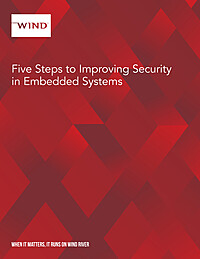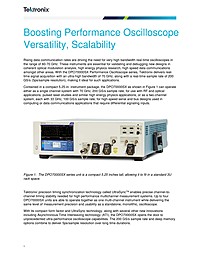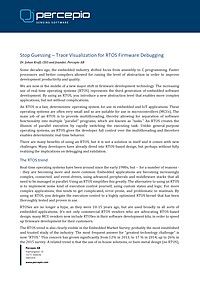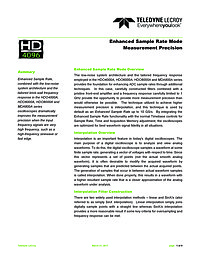
Five Steps to Improving Security in Embedded Systems
In today’s increasingly interconnected world, security breaches are becoming ever more prevalent, with escalating complexity challenges. How can embedded device developers balance the need for tighter security with competing business and market demands? This paper outlines five steps for building additional security assurance into embedded devices by considering the whole product lifecycle.
Interface Protection for HDMI
The High-Definition Multimedia Interface (HDMI) combines a high-speed unidirectional TMDS data link with low speed, bidirectional control and status links (DDC and CEC) and configuration protocols in a single user-friendly highperformance connector.

Creating a State-of-the Art, Cost Effective Energy Harvesting Bluetooth® Low Energy Switch
As IoT rapidly grows into new markets such as MHealth, Agriculture 4.0, and building automation, new questions are being raised about the energy required to support its growth. Within the industry, we see a broad spectrum of power requirements.

Boosting Performance Oscilloscope Versatility, Scalability Whitepaper
Rising data communication rates are driving the need for very high-bandwidth real-time oscilloscopes in the range of 60-70 GHz. These instruments are essential for validating and debugging new designs in coherent optical modulation analysis, high energy physics research, high speed data communications and other areas. With the DPO70000SX Performance Oscilloscope series, Tektronix delivers real-time signal acquisition with an ultra-high bandwidth of 70 GHz, along with a real-time sample rate of 200 GS/s (5ps/sample resolution), making it ideal for such applications.

Stop Guessing – Trace Visualization for RTOS Firmware Debugging
Some decades ago, the embedded industry shifted focus from assembly to C programming. Faster processors and better compilers allowed for raising the level of abstraction in order to improve development productivity and quality. We are now in the middle of a new major shift in firmware development technology. The increasing use of real-time operating systems (RTOS) represents the third generation of embedded software development. By using an RTOS, you introduce a new abstraction level that enables more complex applications, but not without complications.

Enhanced Sample Rate Mode Measurement Precision
The low-noise system architecture and the tailored frequency response employed in the HDO4000A, HDO6000A, HDO8000A and MDA800A series provides the foundation for enhancing ADC sample rates through additional techniques. In this case, carefully constructed filters combined with a pristine front-end amplifier and a frequency response carefully limited to 1 GHz provide the opportunity to provide more measurement precision than would otherwise be possible. The technique utilized to achieve higher measurement precision is interpolation, and this technique is used by default as an Enhanced Sample Rate up to 10 GS/s. By integrating the Enhanced Sample Rate functionality with the normal Timebase controls for Sample Rate, Time and Acquisition Memory adjustment, the oscilloscopes are optimized for best waveform signal fidelity in all situations.
Transforming 64-Bit Windows to Deliver Software-Only Real-Time Performance
Next-generation industrial, vision, medical and other systems seek to combine highend graphics and rich user interfaces with hard real-time performance, prioritization and precision.Today’s industrial PCs running 64-bit Windows, complemented by a separate scheduler on multicore multiprocessors, can deliver that precise real-time performance on software-defined peripherals.
Improving Battery Management System Performance and Cost with Altera FPGAs
The purpose of this white paper is to evaluate improvements to Battery Management System (BMS) performance and cost with Altera® FPGAs. In many high-voltage battery systems, including electric vehicles, grid attached storage and industrial applications, the battery is a significant portion of the system cost, and needs to be carefully managed by a BMS to maximize battery life and to optimize charging and discharging performance. This white paper presents the BMS functional requirements for these applications and outlines existing BMS architectures. Key BMS architectural challenges are discussed and opportunities for Altera devices are identified. For each of these opportunities, the performance and cost of the existing solution are compared with Altera FPGA solutions. Altera devices provide architectural flexibility, scalability, customization, performance improvements, and system cost savings in BMS applications.
Demystifying digital signal processing (DSP) programming: The ease in realizing implementations with TI DSPs
Introduced by Texas Instruments over thirty years ago, the digital signal processor (DSP) has evolved in its implementation from a standalone processor to a multicore processing element and has continued to extend in its range of applications. The breadth of software development tools for the DSP has also expanded to accommodate diverse sets of programmers. From small, low power, yet “smart” devices with applications such as voice and image recognition, to multicore, high-performance compute platforms performing real-time data analytics, the opportunities to achieve the low-power processing efficiencies of DSPs are nearly endless. The TI DSP has benefited from a relatively unique tool suite evolution making it easy and effective for the general programmer and the signal processing expert alike to quickly develop their application code. This paper addresses how TI DSP users are able to achieve the high performance afforded by the TI DSP architecture, in an efficient, easy-to-use development environment.
Electrical Ground Rules Part 3
Best Practices for Grounding Your Electrical Equipment Examining the role of ground as a voltage stabilizer and transient limiter, along with tips on improving safety and signal integrity (Part 3 of 3)

Five Steps to Improving Security in Embedded Systems
In today’s increasingly interconnected world, security breaches are becoming ever more prevalent, with escalating complexity challenges. How can embedded device developers balance the need for tighter security with competing business and market demands? This paper outlines five steps for building additional security assurance into embedded devices by considering the whole product lifecycle.

Creating a State-of-the Art, Cost Effective Energy Harvesting Bluetooth® Low Energy Switch
As IoT rapidly grows into new markets such as MHealth, Agriculture 4.0, and building automation, new questions are being raised about the energy required to support its growth. Within the industry, we see a broad spectrum of power requirements.

Boosting Performance Oscilloscope Versatility, Scalability Whitepaper
Rising data communication rates are driving the need for very high-bandwidth real-time oscilloscopes in the range of 60-70 GHz. These instruments are essential for validating and debugging new designs in coherent optical modulation analysis, high energy physics research, high speed data communications and other areas. With the DPO70000SX Performance Oscilloscope series, Tektronix delivers real-time signal acquisition with an ultra-high bandwidth of 70 GHz, along with a real-time sample rate of 200 GS/s (5ps/sample resolution), making it ideal for such applications.
Transforming 64-Bit Windows to Deliver Software-Only Real-Time Performance
Next-generation industrial, vision, medical and other systems seek to combine highend graphics and rich user interfaces with hard real-time performance, prioritization and precision.Today’s industrial PCs running 64-bit Windows, complemented by a separate scheduler on multicore multiprocessors, can deliver that precise real-time performance on software-defined peripherals.
Interface Protection for HDMI
The High-Definition Multimedia Interface (HDMI) combines a high-speed unidirectional TMDS data link with low speed, bidirectional control and status links (DDC and CEC) and configuration protocols in a single user-friendly highperformance connector.

Stop Guessing – Trace Visualization for RTOS Firmware Debugging
Some decades ago, the embedded industry shifted focus from assembly to C programming. Faster processors and better compilers allowed for raising the level of abstraction in order to improve development productivity and quality. We are now in the middle of a new major shift in firmware development technology. The increasing use of real-time operating systems (RTOS) represents the third generation of embedded software development. By using an RTOS, you introduce a new abstraction level that enables more complex applications, but not without complications.
Improving Battery Management System Performance and Cost with Altera FPGAs
The purpose of this white paper is to evaluate improvements to Battery Management System (BMS) performance and cost with Altera® FPGAs. In many high-voltage battery systems, including electric vehicles, grid attached storage and industrial applications, the battery is a significant portion of the system cost, and needs to be carefully managed by a BMS to maximize battery life and to optimize charging and discharging performance. This white paper presents the BMS functional requirements for these applications and outlines existing BMS architectures. Key BMS architectural challenges are discussed and opportunities for Altera devices are identified. For each of these opportunities, the performance and cost of the existing solution are compared with Altera FPGA solutions. Altera devices provide architectural flexibility, scalability, customization, performance improvements, and system cost savings in BMS applications.
Electrical Ground Rules Part 1
Best Practices for Grounding Your Electrical Equipment A look at circuit grounding and its importance to you, as well as the US AC power system and its use of earth ground (Part 1 of 3)

Enhanced Sample Rate Mode Measurement Precision
The low-noise system architecture and the tailored frequency response employed in the HDO4000A, HDO6000A, HDO8000A and MDA800A series provides the foundation for enhancing ADC sample rates through additional techniques. In this case, carefully constructed filters combined with a pristine front-end amplifier and a frequency response carefully limited to 1 GHz provide the opportunity to provide more measurement precision than would otherwise be possible. The technique utilized to achieve higher measurement precision is interpolation, and this technique is used by default as an Enhanced Sample Rate up to 10 GS/s. By integrating the Enhanced Sample Rate functionality with the normal Timebase controls for Sample Rate, Time and Acquisition Memory adjustment, the oscilloscopes are optimized for best waveform signal fidelity in all situations.
What’s a Multicore Microcontroller?
This tutorial answers the question “What’s a multicore microcontroller?”



















